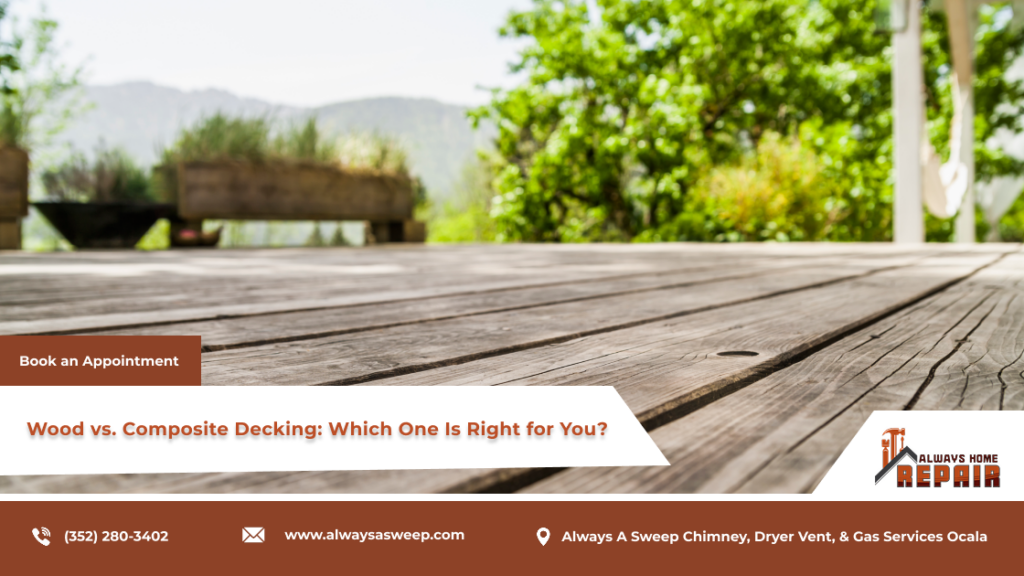Talk to a Certified Contractor at Always Home Repair, Get it Done Right.
- +1 (352) 308 3317
- alwayshomerepair@gmail.com
- Residential Contractor License # CRC1333200
Talk to a Certified Contractor at Always Home Repair, Get it Done Right.

Adding a deck to your home is an excellent way to expand your outdoor living space, increase property value, and create a beautiful spot for relaxation and entertainment. However, when planning your custom deck, one of the most critical decisions is choosing between wood decking and composite decking.
Both materials have unique benefits and drawbacks, and selecting the right one depends on factors like maintenance, budget, aesthetics, and durability. In this blog, we’ll break down the differences between wood and composite decking, helping you decide which option best fits your needs. Plus, we’ll explain how Always Home Repair can assist in designing and installing your ideal deck.
Before diving into the pros and cons, let’s look at what makes these two decking materials unique.
Wood decking is made from natural lumber, offering a classic and timeless appearance. Popular wood choices include cedar, redwood, and pressure-treated pine. Wood decks are known for their natural beauty and organic feel, making them a popular choice for traditional and rustic homes.
Composite decking is a manufactured product made from a blend of wood fibers and recycled plastic. Brands like Trexand Fiberon offer composite boards that mimic the look of natural wood while offering enhanced durability and low maintenance.
Wood has an authentic, natural look that many homeowners find appealing. It can be stained or painted in various colors, allowing for customization and flexibility. The unique grain patterns and textures add a rustic charm to outdoor spaces.
Pros:
Cons:
Composite decking is designed to resemble wood while offering a more consistent color and texture. It’s available in a range of shades and finishes, including wood grain patterns, providing the look of wood without the high maintenance.
Pros:
Cons:
Which One Is Better for You?
If you prefer a natural, organic feel and are willing to put in the upkeep, go with wood decking. If you want consistent aesthetics with minimal maintenance, composite decking is your best bet.
To maintain its beauty and structural integrity, wood decking requires regular care. This includes cleaning, staining, sealing, and occasional sanding. Without proper maintenance, wood can warp, crack, or develop mold.
Maintenance Tasks:
One of the biggest advantages of composite decking is its low maintenance. Unlike wood, composite doesn’t need to be stained or painted. Regular cleaning with soap and water keeps it looking new.
Maintenance Tasks:
Which One Is Better for You?
If you prefer minimal upkeep, composite decking is the clear winner. Wood decking is ideal if you don’t mind putting in the work to preserve its natural beauty.
Natural wood is prone to rot, insect damage, and warping, especially in areas with fluctuating weather. With proper maintenance, a wood deck can last around 10-15 years. However, neglected wood can deteriorate much faster.
Durability Factors:
Composite decking is engineered for durability, with a lifespan of 25-30 years or more. It resists moisture, rot, and insect damage, making it an excellent choice for long-term use.
Durability Factors:
Which One Is Better for You?
If longevity and durability are your priorities, composite decking is the better option. Choose wood decking if you are comfortable with routine maintenance to extend its lifespan.
Wood is generally more affordable upfront, especially when using pressure-treated lumber. However, maintenance costs add up over time due to staining, painting, and repairs.
Cost Breakdown:
The initial investment for composite is higher than wood. However, the savings on maintenance make it a cost-effective option in the long run.
Cost Breakdown:
Which One Is Better for You?
If your budget allows for a higher initial investment, composite decking is worth it. For a more economical upfront option, wood decking works well but requires ongoing maintenance.
Wood is a renewable resource, but some woods, like tropical hardwoods, may contribute to deforestation. Pressure-treated wood often contains chemicals that can leach into the environment.
Composite boards are made from recycled materials, making them an eco-friendly choice. They reduce landfill waste and often come from sustainably sourced materials.
Which One Is Better for You?
If sustainability is important, composite decking is the greener choice. Choose wood decking if you prefer natural materials and opt for certified sustainable wood.
At Always Home Repair, we offer customized solutions for your deck installation and maintenance needs. Whether you prefer the timeless charm of wood decking or the low-maintenance convenience of composite decking, our skilled team can make your vision a reality.
Our goal is to create a beautiful, functional, and durable outdoor space you’ll love for years to come.
Choosing between wood and composite decking doesn’t have to be overwhelming. Our team at Always Home Repair is here to guide you through the decision-making process and ensure your deck is built to last.
Contact us today to schedule a consultation and discuss your decking needs. Whether you want the natural look of wood decking or the hassle-free benefits of composite, we’ve got you covered!